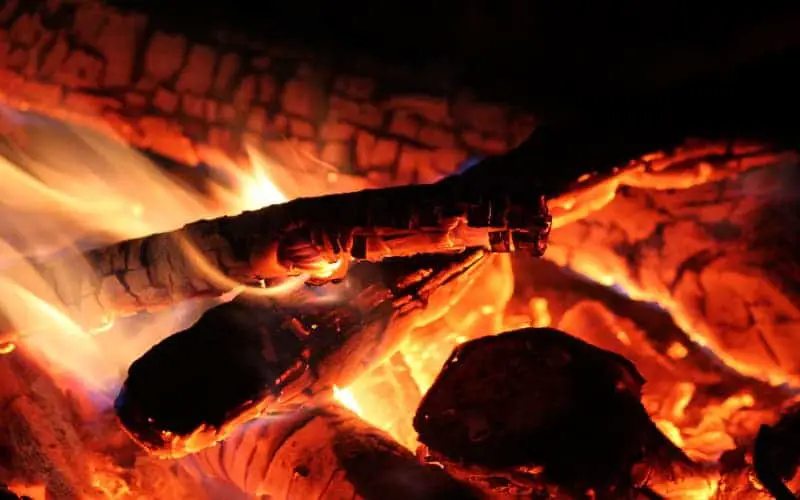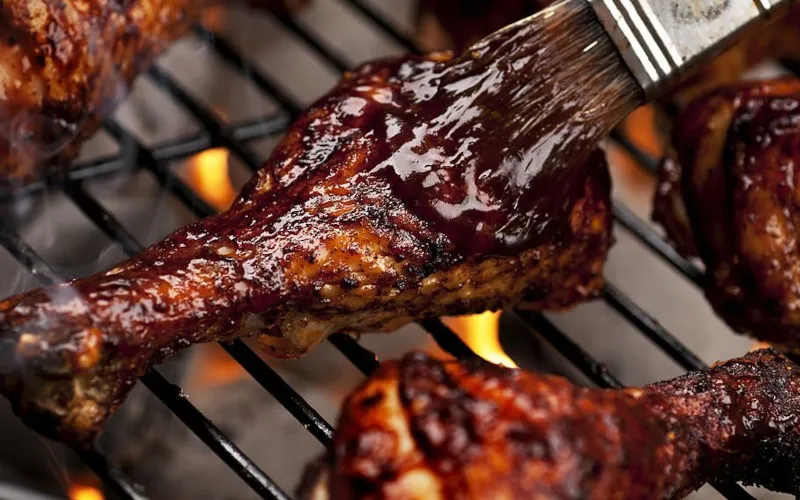Does it matter what kind of wood you use when smoking chicken? Many people say that the results will be the same whether you choose applewood or hickory wood. Is this true?
Smokehouses are a great way to add a dimension of flavor to any meat. While many types of meat go well with smoke, chicken is one of my favorites. Like many people, you’re probably wondering what wood you should use when smoking chicken, and there’s no one correct answer. Different woods will yield different results depending on your tastes, making this decision more difficult.
So, what exactly do we mean by best in this context? While there are certainly some woods that consistently produce good results, they don’t necessarily make the best smoke in all situations.
For example, while you may prefer the flavor that hickory gives to pork ribs over apple or cherry, it might not be the best choice when imparting specific flavors to your chicken or fish.
To cover all of your bases and ensure that you can find good wood for smoking chicken, we’ve compiled a list of some of our favorites. There is no single best wood for smoking chicken, but there are many kinds of wood that will do well if selected carefully.
Best Types of Wood for Smoking Chicken
Many types of wood can be used for smoking chicken. Some woods are better than others, depending on what you’re looking for in your finished product.
Here is a list of all possible types of wood that can be used to smoke chicken In order from mildest flavor to most savory flavor:
Some possible types of wood are apple, cherry, pear, and fruitwoods (such as apple or cherry). These woods will give a nice smoky flavor but won’t overpower your chicken with too much smoke. They also tend not to have as strong of an aroma as some other types of wood.
1. Apple
Applewood is known for its subtle smoky flavor, with hints of both sweet and sour. It’s used most often in traditional American barbecue, which explains why it’s one of Tennessee’s official state trees. In addition to chicken, Apple also pairs very well with pork and lamb.
2. Cherry
Cherry wood is an excellent choice for smoking chicken, especially if you’re looking for a milder flavor. It has a light sweetness that pairs well with poultry and is often used in conjunction with other types of wood, such as hickory or oak.
3. Pear
Pearwood has a subtle flavor that pairs well with poultry, making it a great choice for smoking chicken. It also has a slight sweetness to it, and unlike apple or cherry wood, it won’t overpower your chicken with too much smoke.
Some possible types of wood are oak, alder, pecan, and other hardwoods that are typically used for smoking chicken. These woods will give you more of a traditional smoked meat taste in your chicken.
4. Oak
Oak is a great choice for smoking chicken, especially if you want a more traditional smoked meat taste. The oak family includes several types of wood that can be used to smoke chicken, so while they all will have strong and smoky flavors, they’ll differ slightly based on what kind of oak you use.
Hickory and mesquite are two examples of hardwoods in the oak family.
5. Alder
Alder is one of my favorite woods to use when smoking chicken because it pairs well with poultry without overpowering it with too much smoke or flavor. It has a light sweetness that works well with chicken and salmon, making it an excellent choice for those who like to pair their barbecue meats with sides.
6. Pecan
Pecan is another type of wood with a subtle sweetness, making it a great choice for smoking chicken. It’s also considered one of my favorite woods to use when smoking poultry because it pairs well with just about any type of meat you want to smoke.
Some possible types of wood are walnut, hickory, or any other strong-tasting wood (such as mesquite). These woods will give you an intense smoke flavor, but they can also overpower your chicken with too much smoke.
7. Walnut
Walnut is a very strong-tasting wood that’s often used in conjunction with other types of wood, such as oak or hickory. It has a robust flavor that can easily overpower your chicken if you use too much of it.
Although walnut is a great choice, it’s for smoking meats like pork and beef because it adds an extra flavor to them. However, it can bring your chicken to another level when used well.
8. Hickory
Hickory is another strong-tasting wood that pairs well with chicken. Like walnut, it has a very strong flavor, so you should be careful not to use too much of it, or your chicken will end up tasting almost like hickory-smoked jerky.
9. Mesquite
Mesquite is a hardwood that adds a strong smoky flavor to anything you’re smoking. Because of its intense smoke and taste, it’s one of my favorite woods to use when smoking chicken.
We always like to combine mesquite with another type of wood because you can still get a bit of that intense smoke flavor while also adding another level of taste to your chicken or whatever meat you’re smoking.
Pro tip: Use any of these varieties to create your own signature smoky flavor. Be sure to use dry wood that’s been seasoned for six months or more. This ensures that your wood will burn slowly and hot while giving you great flavor.
Tips for Smoking Chicken
There are a few rules of thumb when it comes to smoked chicken.
1. Consider a fatty part cut of chicken
Chicken, like many other types of meat, tends to dry out when smoked. If you want moist chicken that doesn’t need sauce for flavor or moisture, consider using dark meat (i.e., thighs).
Dark meat is also more forgiving of overcooked and will still be tender and juicy. The breast meat can also be used for smoking, but because it’s leaner, it will take on a chewier texture and is better suited to sauces or brines to keep it moist. Avoid anything with skin as it tends to burn during smoking.
2. Smoke at a low temperature
Smoking is about maintaining low temperatures for long periods, so don’t expect to get your smoker up to 400°F like you might when grilling or roasting meat. In fact, smoking chicken should be done at temperatures below 200°F (93°C).
If you’re using a charcoal smoker, start with white-hot coals and let them burn down until they’re covered in gray ash. If you’re using a gas or electric smoker, keep it between 180° and 225°F (82°-107°C). This will take longer than grilling or roasting but trust us; it’s worth it!
3. Seasoning rule
Even if you’re going to brine or marinate your chicken first (I recommend doing both), stick with natural seasonings—there’s no need for sauces that mask the smoke flavor.
4. Avoid direct heat
If you’re using a charcoal smoker, place your chicken on an indirect cooking rack over a drip pan filled with water or apple juice (or both). If you’re using a gas or electric smoker, use one of its racks to smoke your chicken. This will keep it from drying out and burning while still allowing it to absorb the smoke flavor.
You can also place your chicken in a foil packet poked with holes for added moisture (and extra flavor).
5. Smoke until done— don’t overdo it
Your chicken is done when its internal temperature reaches 160°-165°F (71°-74°C). You can check its progress with a meat thermometer. Just insert it into multiple locations as different parts of your chicken cook at different rates. If you’re using a charcoal smoker, replace burned coals or let new ones burn white-hot before cooking again.
6. Rest before serving
Don’t slice into that smoked chicken right away—let it rest for at least 10 minutes after pulling it off the smoker. This allows those delicious juices to settle back into the meat before serving.
If you want to speed up that process, place your cooked chicken in an aluminum foil pan and cover it with a lid or heavy-duty foil (this also helps keep your kitchen from smelling like smoke).
7. Serve hot or cold
Smoked chicken is great served warm or cold, so don’t be afraid to make extra and enjoy leftovers for lunch later in the day! Just reheat any leftovers thoroughly until they’re steaming hot throughout.
Frequently Asked Questions
How to Smoke Chicken Breast?
Smoking chicken breast produces tender and moist meat. We know that chicken breasts can dry out very quickly, but you can get excellent results with care. The key is to use low temperatures for long cooking times, and you’ll be well on your way to mouth-watering smoked chicken breasts.
Another important thing is not to overcook them—the internal temperature should be 160°F (71°C). Place the breasts with the skin-side up on a rack in your smoker, using indirect heat. Add smoke for flavor. The type of wood you use can also influence your chicken breast’s taste.
Many people swear by applewood, which produces a mild flavor that helps complement chicken. Pecan and cherry are also popular choices. If you like a more pungent taste, hickory is another good option. Alder isn’t as strong, but it adds an appealing aroma to your chicken’s exterior.
How to Smoke Chicken Wings?
Smoking chicken wings can be challenging, but it’s a task worth undertaking. A smoked chicken wing has a flavor that is uniquely its own. It’s similar to an oven-roasted wing, with better texture and flavor intensity. The result is well worth putting in a little extra effort!
First, you need to brine your wings overnight in water mixed with kosher salt and sugar. Leave your chicken in until it absorbs enough liquid to plump up nicely before smoking.
Next, set up your smoker for indirect heat and place your wings on a rack where they can smoke-cook slowly over low temperatures of 225°F (107°C). Be sure not to put them directly over any flame or heat source—you don’t want to scorch them!
How to Smoke Chicken Thighs?
Smoked chicken thighs make an excellent choice for a complete meal. They’re substantial enough to serve as the main course and can be cooked differently. They have a rich flavor that makes them great on their own, but they also mix well with other dishes and ingredients.
When cooking smoked chicken thighs, the most important thing is not to overcook them. The best way to enjoy smoked chicken thighs is when they still have some pink inside; otherwise, they become dry and tough.
It’s possible to brine chicken thighs before smoking them, but if you don’t have time for that, you can still do several things—such as marinating—to get fantastic results without much effort at all.
How to Smoke Chicken Quarters?
Smoked chicken quarters can be cooked in a variety of ways. You can serve them as is with some side dishes, use them to make an excellent sandwich, or chop them up for soup stock. The possibilities are endless!
To cook smoked chicken quarters, you’ll want to cook with indirect heat at a temperature of 250°F (121°C). It’s important not to overcook them, so monitor your smoker while they cook and remove each quarter once it reaches 160°F (71°C).
Don’t forget to add smoke flavor! Alder wood works well here, but any hardwood will do just fine.
How to Make Smoked Jerk Chicken Wings?
Making smoked jerk chicken wings is easy to follow with simple steps. First, you’ll need some jerk seasoning. You can find it in your local grocery store or make your own with ingredients like thyme, onion powder, garlic powder, and black pepper.
To make smoked jerk chicken wings, start by brining them overnight in a mixture of water and salt. Next, set up your smoker for indirect heat at 225°F (107°C). Smoke-cook your wings for about an hour before brushing them with jerk sauce and returning them to smoke-cook for another 30 minutes.
Conclusion
There are four main types of wood that you can use to smoke meat: hardwoods (e.g., oak), fruitwoods (e.g., apple), softwoods (e.g., pine), and coniferous woods (e.g., cedar). Each one imparts its unique flavor to your food, so wisely choose your wood.
If you’re new to smoking meats, we recommend starting with something mild like cherry. As for which is best? There’s no correct answer; it all depends on what kind of flavor profile you’re looking for in your finished product.
However, if we had to pick just one type of wood as my favorite for smoking chicken, we think we’d go with hickory every time!





